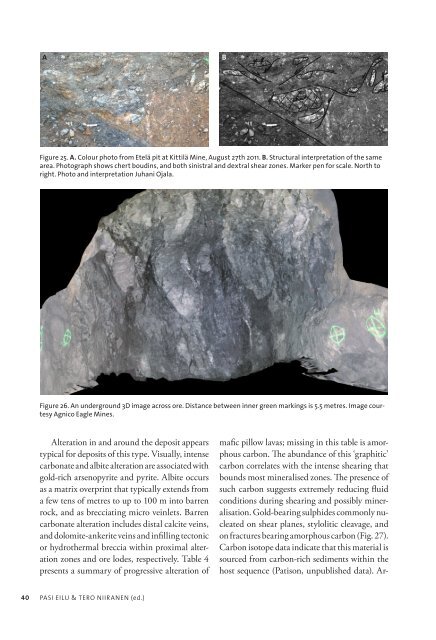Gold deposits in northern Finland - Arkisto.gsf.fi
Gold deposits in northern Finland - Arkisto.gsf.fi
Gold deposits in northern Finland - Arkisto.gsf.fi
You also want an ePaper? Increase the reach of your titles
YUMPU automatically turns print PDFs into web optimized ePapers that Google loves.
A<br />
B<br />
Figure 25. A. Colour photo from Etelä pit at Kittilä M<strong>in</strong>e, August 27th 2011. B. Structural <strong>in</strong>terpretation of the same<br />
area. Photograph shows chert boud<strong>in</strong>s, and both s<strong>in</strong>istral and dextral shear zones. Marker pen for scale. North to<br />
right. Photo and <strong>in</strong>terpretation Juhani Ojala.<br />
Figure 26. An underground 3D image across ore. Distance between <strong>in</strong>ner green mark<strong>in</strong>gs is 5.5 metres. Image courtesy<br />
Agnico Eagle M<strong>in</strong>es.<br />
Alteration <strong>in</strong> and around the deposit appears<br />
typical for <strong>deposits</strong> of this type. Visually, <strong>in</strong>tense<br />
carbonate and albite alteration are associated with<br />
gold-rich arsenopyrite and pyrite. Albite occurs<br />
as a matrix overpr<strong>in</strong>t that typically extends from<br />
a few tens of metres to up to 100 m <strong>in</strong>to barren<br />
rock, and as brecciat<strong>in</strong>g micro ve<strong>in</strong>lets. Barren<br />
carbonate alteration <strong>in</strong>cludes distal calcite ve<strong>in</strong>s,<br />
and dolomite-ankerite ve<strong>in</strong>s and <strong>in</strong><strong>fi</strong>ll<strong>in</strong>g tectonic<br />
or hydrothermal breccia with<strong>in</strong> proximal alteration<br />
zones and ore lodes, respectively. Table 4<br />
presents a summary of progressive alteration of<br />
ma<strong>fi</strong>c pillow lavas; miss<strong>in</strong>g <strong>in</strong> this table is amorphous<br />
carbon. The abundance of this ‘graphitic’<br />
carbon correlates with the <strong>in</strong>tense shear<strong>in</strong>g that<br />
bounds most m<strong>in</strong>eralised zones. The presence of<br />
such carbon suggests extremely reduc<strong>in</strong>g fluid<br />
conditions dur<strong>in</strong>g shear<strong>in</strong>g and possibly m<strong>in</strong>eralisation.<br />
<strong>Gold</strong>-bear<strong>in</strong>g sulphides commonly nucleated<br />
on shear planes, stylolitic cleavage, and<br />
on fractures bear<strong>in</strong>g amorphous carbon (Fig. 27).<br />
Carbon isotope data <strong>in</strong>dicate that this material is<br />
sourced from carbon-rich sediments with<strong>in</strong> the<br />
host sequence (Patison, unpublished data). Ar<br />
40 Pasi Eilu & Tero Niiranen (ed.)
















